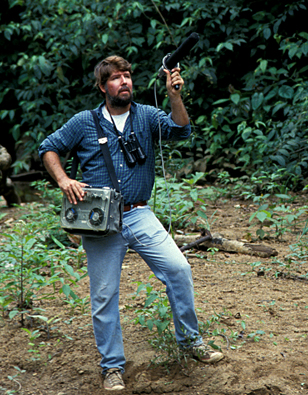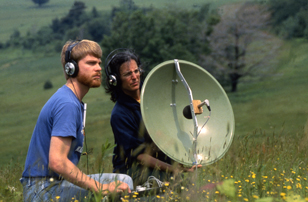Expansion (1970-2000)

The latter decades of the Twentieth Century were a period of exponential growth for the Library of Natural Sounds (LNS) as it expanded from about 15,000 recordings to over 140,000. Accordingly, LNS became a world leader in research on the vocalizations of birds and other animals. Highlights from this dynamic era include:
- 1974: Dr. James L. Gulledge was appointed as Director and Curator of LNS. He ushered in a renaissance for LNS by securing key outside funding (including grants from the National Science Foundation), bringing on new staff with specialized skills, engaging and supporting field recordists, and overseeing seven successive commercial productions.
- The 1970’s and 1980’s saw significant expansion of the LNS collection of neotropical birds, in part through partnerships with legendary ornithologists Paul Schwartz and Theodore “Ted” A. Parker III, among others. Parker, in particular, set out to create “the best collection of Neotropical bird sounds” anywhere. Parker did what he set out to do: at the time of his untimely death in a plane crash in 1993, he had made more than 10,000 recordings of nearly 2,000 species of birds.
- 1984: LNS conducted its first sound recording course, taught by LNS Assistant Curator Greg Budney in Machias, Maine. This innovative program, which sought to provide advanced training in field sound recording of animals, continues to be taught today and has trained hundreds of highly-qualified field recordists from across the globe.
- 1987: Gulledge retired and was replaced by former Assistant Curator Budney, who brings on Robert Grotke, a highly respected sound engineer. Under the careful oversight of Budney and Grotke, the LNS collection grew to over 140,000 recordings, the Sound Recording Workshop prospered, a diverse set of commercial and wildlife management productions was completed, and LNS generally evolved to become the world’s greatest archive of animal sounds.
Expanding the mission

In 1974, Dr. James L. Gulledge joined the staff of the Lab of Ornithology as director and curator of the Library of Natural Sounds (LNS). By then, LNS held approximately 15,000 recordings but was still growing at a rate far below what Gulledge viewed as its potential. He ushered in a renaissance for LNS and under his leadership, the LNS developed exponentially. He secured outside funding, brought on new staff, sought out those making field recordings, and worked with others to develop necessary recording skills. He also oversaw seven successive commercial productions culminating with Warblers of North America by Donald J. Borror and William W. H. Gunn, a comprehensive guide to the vocalizations of North American warblers.
Several instrumental steps were taken by Gulledge to turn LNS from a curiosity into a biological research resource. At the time, Gulledge and assistant Andrea Priori comprised the entire staff of LNS. One of his first steps was to seek out technical expertise for maintaining and upgrading the LNS studio facilities. He recruited David Wickstrom, a capable local audio engineer, whose skills rejuvenated the aging equipment and permitted archival of the recordings that Gulledge was soliciting from field researchers worldwide. To spur the process, Gulledge and Priori accepted tropical recordist Paul Schwartz’s invitation to visit Venezuela and copy over 5,000 recordings of neotropical birds for the LNS archive. Working day and night, they completed this challenging task in only two weeks, a process that also included photographing thousands of Schwartz’s hand-written data forms as photocopying equipment was not available in Venezuela at that time.

The LNS archival format in this period remained reel-to-reel magnetic tape. Gulledge recognized that the workhorse recording and archival equipment of the 1960s, though serviceable, would require replacement and more machines were required to handle the amount of un-archived recordings he was actively recruiting. In 1978, Gulledge wrote the first of what would be several National Science Foundation (NSF) proposals for supporting the curatorial operations of LNS. With NSF support, LNS acquired a battery of new studio recorders and instituted a plan for copying recordings that had been submitted for archival. At the same time, Gulledge redesigned LNS’s longhand data form into a check-off form based on keyword fields to encourage recordists to provide more data and began the process of entering text data into a computerized database.

Around the same time, one of the more fortuitous events to occur in the history of LNS took place. Gulledge began corresponding with Theodore “Ted” A. Parker, III. In early correspondence, Parker promised to create “the best collection of Neotropical bird sounds” anywhere. Gulledge recognized the skill and drive in Parker and provided him with equipment, tape, and encouragement (though it would soon become apparent that a minimal amount of the latter was required). Building upon the contributions of others such as Paul A. Schwartz, Parker did what he set out to do. At the time of his untimely death in a plane crash in 1993, Ted Parker alone made more than 15,000 recordings of over 1,600 species of birds. The contact and success with Parker spawned other connections. Cooperative links with field workers from Cornell and other institutions in North America as well as other parts of the world were established. As a result, significant new material from South America, Africa, Asia, and North America flowed into the collection and continues to do so today.


In 1984 Gulledge received a phone call from Charles D. Duncan, director of the recently developed Institute for Field Ornithology (IFO) at the University of Maine at Machias. Duncan was interested in having LNS conduct a sound recording course at the IFO. Gulledge offered the possibility of having his assistant curator, Greg Budney, do so. That year the first Natural Sound Recording Course was conducted in Machias, Maine. In 1987, at the suggestion of Ted Parker, Budney invited Randolph Little (a former assistant to Kellogg when a Cornell student and at this time on the staff at Bell Labs) to be an instructor at a sound recording course in Ithaca. This innovative program sought to provide advanced training in field sound recording of animals, and has since graduated hundreds of highly-qualified field recordists. Some have gone on to become research scientists specializing in some aspect of animal sound communication. Others now record animal sounds as an avocation. Many continue to send new high-quality recordings to the Library from throughout the world.

